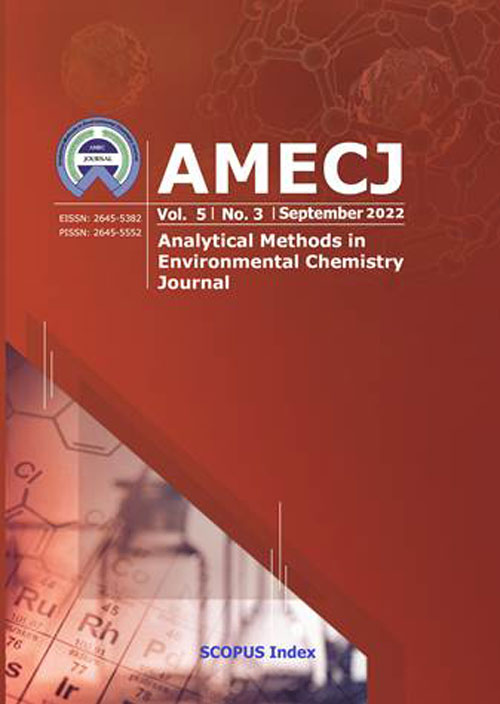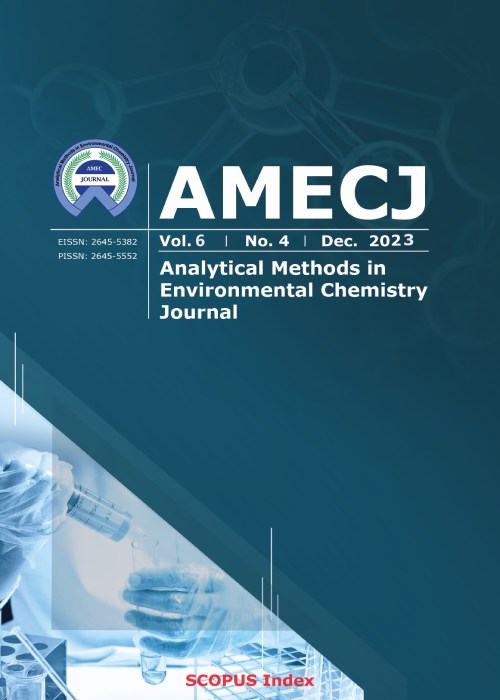فهرست مطالب

Analytical Methods in Environmental Chemistry Journal
Volume:5 Issue: 3, Sep 2022
- تاریخ انتشار: 1401/08/09
- تعداد عناوین: 7
-
Pages 5-18
Humic acid (HA) has a complex chemical composition and the ability to chelate, adsorb, and exchange ions with organic and inorganic contaminants in bodies of water, which worsens water quality and poses a threat to human health and the environment. In this research, an Ultraviolet-activated sodium perborate (UV/SPB) symbiotic method (UV/SPB) was developed to eliminate humic acid in water. The major synergistic and degradative processes of the humic acid were investigated, as well as the impact of the starting humic acid concentration, sodium perborate dose, and primary pH value on the humic acid elimination. Results indicate that just 0.5 % and 1.5 % of humic acid were eliminated mostly by sole UV and sole sodium perborate (SPB) methods, respectively. More effectively than other methods, UV/SPB removed humic acid with an efficiency of 88.83%. An experiment using free radicals to mask them revealed that the primary catalyst for humic acid removal is the hydroxyl radical generated by sodium perborate activation. The excitation-emission matrix spectroscopy, Ultraviolet-visible absorption (UV-Vis) spectrum, absorbance ratio values, specific Ultraviolet-visible absorbance values (SUVA), and UV/SPB method performance findings demonstrated the UV/SPB method’s capability to degrade and mineralize humic acid.
Keywords: Absorption, UV-vis spectrum, Environment, Contaminants, Humic acid -
Pages 19-30
As main air pollutants, volatile organic compounds (VOCs) must be paid special attention. In this study, the removal efficiency of xylene from the air was investigated by nano-activated carbons (NACs) as an efficient adsorbent and compared to commercial activated carbons (ACs). In the chamber, the xylene vapor in pure air was generated, stored in the airbag (5 Li), and moved to adsorbents. Then, the xylene vapor was absorbed on the NAC/AC adsorbents and desorbed from it by a heat accessory. The efficiency of xylene removal with NACs and ACs was investigated in the dynamic and static systems based on 100-700 mg L-1 of xylene, flow rates of 100 ml min-1, and 100 mg of adsorbent at a humidity of 32% (25°C). Xylene concentrations were determined by gas chromatography equipped with a flame ionization detector (GC-FID). In the batch system, the maximum absorption capacity for NACs and ACs was obtained at 205.2 mg g-1 and 116.8 mg g-1, respectively. The mean adsorption efficiency for NACs and ACs adsorbents was obtained at 98.5% and 76.55%, respectively. The RSD% for NACs ranged between 1.1-2.5% in optimized conditions. The characterizations of the NACs adsorbent showed that the particle-size range was between 35-100 nm. The results showed that the adsorption efficiency of NACs for removing xylene from the air was achieved more than ACs. The GC-MS validated the proposed procedure in real air samples.
Keywords: Xylene, Adsorption, Air, Nano activated carbon, Dynamic system, Gas chromatography -
Pages 31-39
The presence of pharmaceutical compounds in aqueous media, even in low concentrations, has caused adverse effects on human, animal, and environmental health. Captopril is a widely used pharmaceutical compound detected in the environment at different concentrations. Because of the concern and problems caused by the presence of captopril in water and the aquatic ecosystem, it appears necessary to remove it from the environment. The current study investigated captopril removal by a catalytic ozonation process using ZnO/Fe2O3nanocomposite as a low-cost catalyst. The effects of variables such as ZnO/Fe2O3 nanocomposite dosage (0.5-2.5 g L-1), solution pH (3-11), initial captopril concentration (10-70 mg L-1), and ozone dosage (0.2-1.5 mg min-1) on captopril removal were investigated. The removal captopril of 99.4% was obtained in the optimum condition, including ZnO/Fe2O3 nanocomposite dosage of 2.0 g L-1, solution pH of 5.0, initial captopril concentration of 40 mg L-1, and ozone dosage of 0.5 mg min-1. The ZnO/Fe2O3 nanocomposite as a catalyst was a critical component in the catalytic ozonation process. According to the obtained results, the catalytic ozonation process in the presence of ZnO/Fe2O3 nanocomposite has high efficiency in removing captopril from water sources.
Keywords: Captopril, Catalytic ozonation, ZnO, Fe2O3 nanocomposite, Removal, Aqueous solution -
Pages 40-54
The present study reported the preparation of solid phases from various available and cheap natural sources represented by activated carbon to remove the polluting dye Congo Red (CR). Activated carbon derived from the leaves of the Consocarpus plant (C/AC) and Ziziphus Spina-Christi plant (Z/AC) and Myrtus plant (M/AC) by chemical activation. The prepared solid phases were diagnosed and examined using FTIR, FESE, and XRD. The results of the study indicated that the best amount for the solid phase was 0.25 g for the three solid phases used against dye, the optimal concentration of the CR was 100 mg L-1, and the optimum acidity function was equal to 5 with a volume of 25 mL, as the optimization experiments indicated that the best flow rate of the eluting solution was equal to 0.5 ml min-1. The elution processes were carried out using several solvents different in polarity and it was found that 8 mL of DMSO achieved the best percentage of recovery (%R). Also, this study included calculating adsorption capacity based on the optimal conditions that were obtained by applying Langmuir and Freundlich isotherm models, and qmax, according to the Langmuir model, was (21.74, 23.53, 22.17) mg g-1for (Z/AC), (C/AC), and (M/AC) adsorbents, respectively.
Keywords: Solid phase extraction, Active carbon, Congo Red, Enrichment factor, UV-Vis technology -
Pages 55-69
The negative environmental impact generated by fossil fuel has resulted in the demand to search for alternative routes of renewable sources of energy, such as biodiesel, that have unlimited duration while having little or no hazardous impact. In this study, trans-esterification of palm kernel oil and groundnut oil was carried out using sodium methoxide (CH3ONa) as a catalyst. The effect of varying Sodium Methoxide (CH3ONa) catalyst concentrations of (0.25, 0.5, 1.0, 1.5, and 2.0) % w/v at trans-esterification temperatures of (50, 55, and 60) oC on the yield of biodiesel from groundnut oil and palm kernel oil was determined. This was to identify the catalyst concentration and trans-esterification temperature with optimal process yield. The process gave optimum biodiesel yields of 98% and 84% by volume of groundnut oil and palm kernel oil at reaction conditions of 0.5%w/v CH3ONa as catalyst, trans-esterification temperature of 55oC, 360 rpm mixing rate and a reaction time of 90 minutes. The biodiesel produced was analyzed for fuel properties using the American Society of Testing and Materials (ASTM) standard, and the results obtained were as follows; specific gravity (0.8835, 0.8815 at 15oC), flash point (98, 124) oC, viscosity (5.2, 7.6) mm2S-1at 40oC, pour point (9, -1)oC, iodine value (8.04, 17.11) /100, acid value (0.67, 0.48) mg/KOH/g, peroxide value (28, 60) mg Kg-1, fire point (108,136)oC for palm kernel oil and groundnut oil respectively.
Keywords: Biodiesel, Trans-Esterification, Mineral diesel, Palm kernel oil, Groundnut oil, Optimization -
Pages 70-79
In this study, the amino-functionalized metal-organic framework (NH2-MOFs) was used as an adsorbent for the extraction of cadmium in rice samples based on the pipette tip solid phase extraction (PT-SPE) before determined by the flame absorption spectrometry (F-AAS). The pH of the sample solution, initial concentration of the cadmium, the volume of the sample, elution conditions, and the amount of adsorbent on the recovery of the cadmium were investigated and optimized. The results showed that the best extraction efficiency of cadmium was obtained at pH 5.0, 2500.0 μL of cadmium solution, and 20.0 μL of HCl (10% V/V) as eluent solvent. First, the cooking rice was transferred to a beaker and hydrochloric acid/nitric acid was added to it as a digestion process before analysis by the PT-SPE procedure. The limit of detection of this method was found to be 0.03 μg L-1 with a relative standard deviation of ≤ 2.5 % (for seven replicate analyses of 50 μg L-1 of cadmium). The linear and dynamic ranges were achieved at 0.3 -14.5 μg L-1 and 0.3 -150 μg L-1, respectively. The adsorption capacity of sorbent and enrichment factor was 175 mg g-1 and 125 folds, respectively. The proposed method was successfully applied for the determination of cadmium in rice samples.
Keywords: Cadmium, Amino functionalized metal-organic framework, Pipette tip extraction, Rice samples, Atomic adsorption spectrometer -
Pages 80-102
Total vaporization solid-phase microextraction (TV-SPME) is a type of extraction technique in which a specific solvent dissolves the analyte. Then a tiny amount of solvent is taken to the vial of SPME. Then, the solvent vaporizes in the SPME vial, and sampling is carried out on the headspace of the SPME fiber. As a result, the partitioning phase of the analyte between the headspace and liquid sample is omitted. The equilibrium phase remains the analyte partitioning between the headspace and SPME.TV-SPME was introduced in 2014 by Goodpaster to increase the recovery compared to the liquid injection method. This review discusses different aspects of TV-SPME, including its impact on sampling techniques, theoretical part, sampling procedure, and method optimization. Special attention was paid to its applications. A comprehensive literature study was conducted in the relevant databases to summarize the research work that has been done on this technique. In TV-SPME, the liquid samples completely vaporized and had a less matrix effect and better adsorption. This method needs no sample preparation, consumes less supply, and can be done automatically. Also, TV-SPME enables a cost-effective and efficient extraction for different matrixes. This review summarizes aspects related to TV-SPME including its sampling procedure, method optimization, and its preference for conventional liquid methods. Special attention was paid to its applications of the vacuum-assisted total vaporization solid-phase microextraction procedure (VA-TV-SPME).
Keywords: Solid-phase microextraction, Headspace solid-phase microextraction, Total vaporization solid-phase microextraction, Vacuum-assisted total vaporization solid-phase microextraction, Method optimization


